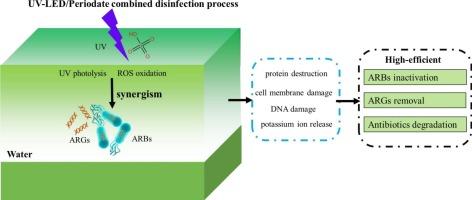新型UV-LED/高碘酸盐联合工艺高效消毒水中耐药细菌:机理与性能评价
IF 6.7
2区 工程技术
Q1 ENGINEERING, CHEMICAL
引用次数: 0
摘要
抗生素耐药细菌(ARB)和抗生素耐药基因(ARGs)已成为持久性水传播污染物,构成严重的环境和公共卫生问题。迫切需要创新和高效的消毒技术来消除这些污染物。本文研究了一种新型的高级氧化工艺(AOP),将波长为265 nm、280 nm和310 nm的紫外发光二极管(uv - led)与高碘酸盐(PI)结合使用,以评估其去除arb和细胞内ARGs的性能。265或280 nm的UV-lED/PI工艺显著增强了细菌灭活,在30秒内实现了5-log的降低,超过了之前报道的大多数AOPs的性能。相比之下,UV-LED 310 nm/PI工艺的消毒效率相对较低(120秒内降低1.4 log)。UV-LED与PI之间存在明显的协同效应,与单独UV-LED照射相比,能耗更低。尽管腐植酸、悬浮物和碳酸氢盐等天然水成分具有中等抑制作用,但总体消毒性能仍然很高。自由基猝灭、SEM、FTIR光谱和钾离子泄漏分析表明,微生物失活主要是由UV-LED照射和羟基自由基(HO•)驱动的,羟基自由基破坏了细胞膜的完整性,破坏了二级蛋白结构。此外,UV-LED 265 nm/PI工艺对四环素类抗生素的降解率达到65 - 80%,在30 min内有效去除int1和sul1基因,分别达到2.37-log和2.18-log。这些发现表明,UV-LED/PI工艺是一种高效,节能,有前途的技术,用于控制水处理中的抗生素抗性污染物。本文章由计算机程序翻译,如有差异,请以英文原文为准。

Highly efficient disinfection of antibiotic-resistant bacteria in water using a novel UV-LED/periodate combined process: mechanisms and performance evaluation
Antibiotic-resistant bacteria (ARB) and antibiotic resistance genes (ARGs) have become persistent waterborne contaminants, posing serious environmental and public health concerns. Innovative and efficient disinfection technologies are urgently needed for eliminating these pollutants. Here, a novel advanced oxidation process (AOP) was developed by combining ultraviolet light-emitting diodes (UV-LEDs) at three wavelengths (265 nm, 280 nm, and 310 nm) with periodate (PI) to evaluate its performance in eliminating ARBs and intracellular ARGs. The UV-lED/PI process at 265 or 280 nm significantly enhanced bacterial inactivation, achieving >5-log reductions within 30 s and exceeding the performance of most previously reported AOPs. By contrast, the UV-LED 310 nm/PI process showed relatively low disinfection efficiency (<1.4-log reduction within 120 s). An obvious synergistic effect between UV-LEDs and PI was observed, resulting in lower energy consumption compared to UV-LED irradiation alone. Although natural water constituents such as humic acid, suspended solids, and bicarbonate exerted moderate inhibitory effects, the overall disinfection performance remained high. Radical quenching, SEM, FTIR spectroscopy, and potassium ion leakage analysis revealed that microbial inactivation was primarily driven by UV-LED irradiation and hydroxyl radicals (HO•), which compromised cell membrane integrity and disrupted secondary protein structures. Furthermore, the UV-LED 265 nm/PI process achieved 65–80 % degradation of tetracycline antibiotics and effectively removed int1 and sul1 genes by 2.37-log and 2.18-log within 30 min, respectively. These findings demonstrate that the UV-LED/PI process is a highly efficient, energy-saving, and promising technology for controlling antibiotic-resistant contaminants in water treatment.
求助全文
通过发布文献求助,成功后即可免费获取论文全文。
去求助
来源期刊

Journal of water process engineering
Biochemistry, Genetics and Molecular Biology-Biotechnology
CiteScore
10.70
自引率
8.60%
发文量
846
审稿时长
24 days
期刊介绍:
The Journal of Water Process Engineering aims to publish refereed, high-quality research papers with significant novelty and impact in all areas of the engineering of water and wastewater processing . Papers on advanced and novel treatment processes and technologies are particularly welcome. The Journal considers papers in areas such as nanotechnology and biotechnology applications in water, novel oxidation and separation processes, membrane processes (except those for desalination) , catalytic processes for the removal of water contaminants, sustainable processes, water reuse and recycling, water use and wastewater minimization, integrated/hybrid technology, process modeling of water treatment and novel treatment processes. Submissions on the subject of adsorbents, including standard measurements of adsorption kinetics and equilibrium will only be considered if there is a genuine case for novelty and contribution, for example highly novel, sustainable adsorbents and their use: papers on activated carbon-type materials derived from natural matter, or surfactant-modified clays and related minerals, would not fulfil this criterion. The Journal particularly welcomes contributions involving environmentally, economically and socially sustainable technology for water treatment, including those which are energy-efficient, with minimal or no chemical consumption, and capable of water recycling and reuse that minimizes the direct disposal of wastewater to the aquatic environment. Papers that describe novel ideas for solving issues related to water quality and availability are also welcome, as are those that show the transfer of techniques from other disciplines. The Journal will consider papers dealing with processes for various water matrices including drinking water (except desalination), domestic, urban and industrial wastewaters, in addition to their residues. It is expected that the journal will be of particular relevance to chemical and process engineers working in the field. The Journal welcomes Full Text papers, Short Communications, State-of-the-Art Reviews and Letters to Editors and Case Studies
 求助内容:
求助内容: 应助结果提醒方式:
应助结果提醒方式:


